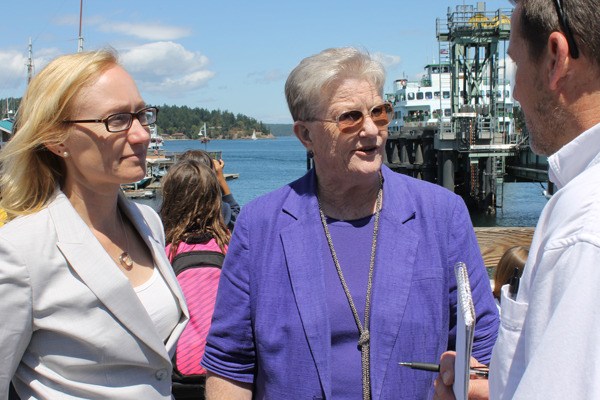Lynn Peterson, chief of Washington State Ferries and the secretary of the state Department of Transportation, came to San Juan Island to find out the state of the ferries reservation system.
Although somewhat mixed, the reviews were mostly positive, according to Lynne Griffith, assistant secretary of the ferries division.
“I’d say everyone that we met with said the reservation system is a good idea, but that it needs some tweaking,” said Griffith, who, along with Peterson met one-on-one, or in pairs, with about a dozen local leaders and island merchants June 12 in Friday Harbor.
Griffith said that changes here and there could prove beneficial, but the system in place in the San Juan Islands and its “30-30-30” staggered reservations release appears to be working well for a significant number of islanders that depend on the ferries either personally or for business. State ferries could improve in the communication arena, she said, and in promoting greater awareness that 10 percent of space on any sailing remains available not only for those with medical emergencies, but for “standbys” and “drive-ups” as well.
For the ferries that run the Anacortes/San Juan route, 10 percent means that 12-14 cars can make it on as standbys and drive-ups since the ferries can carry 124-144 cars. However, according to Broch Bender of the WSDOT Ferries Division, that number can vary depending on how many oversized vehicles there are, such as trailers, semi-trucks and campers. This can reduce the amount of available car spaces to unforeseeable slim numbers.
This is the first summer season for reservations in the San Juans and Griffith maintains that WSF will have better understanding of what changes could help improve the system in the long-run after more information and data become available. For now, she said, WSF will concentrate on improvements that can be implemented in the short-run, like ensuring workers at the ticket booth have up-to-date information about reservations and available space on each and every sailing.
Peterson recently met with state Sen. Kevin Ranker, D-Orcas Island, who conveyed to her some of the concerns voiced by local residents about the reservations and offered suggestions of how the system might be improved.
“One thing is for sure,” Ranker said in a news release, “the implementation of the reservation system is a work in progress and while I do not anticipate, nor do I support, the repeal of the system, there are likely to be changes made as we learn what works and what doesn’t.”
The system might work a bit better if more than 10 percent of any sailing is left available for drive-ups, Friday Harbor Town Administrator Duncan Wilson said.
“I encouraged them to think about loosening up the drive-up space,” Wilson said. He was among the dozen or so people who met with the two state transportation leaders. “Something like 80/20 percent might help make people thinking about making a last minute day-trip to the island more comfortable to know that they can get back to the mainland.”
Due to the nature of change, Wilson believes adapting to the reservation system will be a benefit to some and difficult for others.
“No matter what you do, somebody is going to have to compromise,” he noted.
Despite glitches and opportunities for improvement, Peterson is encouraged from the response heard last week about reservations. The people that she and Griffith met with represent a diverse group of community stakeholders, she said.
“In general, the reaction to reservation is favorable,” Peterson said. “But we certainly heard quite a few good ideas for improvement.”




